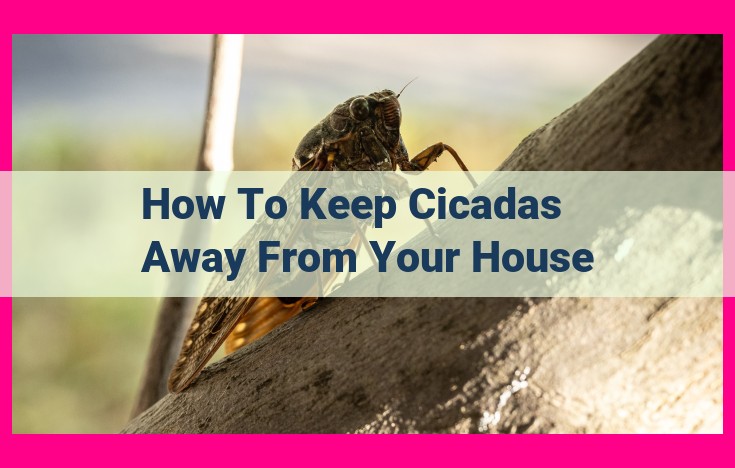Effective Cicada Deterrence: Preventative Measures For Home Protection

To keep cicadas away from your home, consider the following preventive measures:
- Repel with scents: Cicadas dislike strong scents. Plant lavender, garlic, or rosemary around your home.
- Create barriers: Install screens on windows and doors, and seal any gaps in your home’s exterior. Cover trees and shrubs with netting.
- Use natural remedies: Spray a mixture of vinegar and water around your property. Apply soapy water to plants to deter cicadas from feeding.
Cicadas: A Symphony of Nature
In the realm of insects, cicadas stand out as captivating creatures, renowned for their distinctive humming chorus and fascinating life cycle. These enigmatic insects have captivated the curiosity of naturalists and scientists alike, unraveling a tapestry of intricate biological processes.
A Journey Through the Cicada’s Life
The life cycle of a cicada is a saga spanning years. It begins with eggs meticulously laid in the crevices of tree branches. Upon hatching, the nymphs embark on an extraordinary subterranean odyssey, feeding on the nutrient-rich sap of plant roots. After several molts, they emerge as adults, adorned with transparent wings and an unwavering determination to propagate.
A Sonic Symphony
One of the most characteristic features of cicadas is their buzzing songs, a remarkable symphony that reverberates through summer nights. These songs, produced by specialized sound-producing organs, serve as a mating call, enabling cicadas to find their mates amidst the cacophony of nature.
Habitat and Distribution
Cicadas prefer habitats with ample vegetation and moisture, establishing colonies in woodlands, meadows, and even urban areas. Their distribution is influenced by factors such as temperature, soil conditions, and the presence of host plants.
Cicada Impact and Management: Navigating the Challenges
Cicadas, known for their distinctive buzzing songs, can sometimes cause a nuisance and even damage to plants and trees. Understanding their impact and employing effective management strategies is crucial for mitigating potential risks.
Unveiling the Impact of Cicadas
Cicadas mainly pose a threat to plants and trees by feeding on their xylem. These insects insert their piercing mouthparts into the plant’s vascular system, sucking up crucial fluids and nutrients. This can lead to wilting, stunting, and reduced fruit or seed production in affected plants. In extreme cases, severe infestations can cause plant dieback or even death.
Empowering Yourself with Practical Control Strategies
Controlling cicada populations requires a combination of approaches. Cultural practices, such as timing plant selection and avoiding susceptible species, can help minimize damage. Additionally, mechanical methods, including hand-picking, pruning infected branches, and using barriers, can be effective in reducing cicada numbers.
For larger infestations, chemical control may be necessary. Insecticides specifically targeted for cicadas can provide effective suppression. However, it’s essential to follow label instructions carefully and consider potential environmental impacts before using any chemical treatment.
Evaluating Control Methods and Balancing Environmental Considerations
Different control methods have varying levels of effectiveness and environmental implications. Mechanical methods are generally considered environmentally friendly, while chemical control should be used judiciously and with an assessment of potential risks.
Monitoring cicada populations through regular surveys and timing control measures strategically can help minimize the use of pesticides. Additionally, exploring biological control options, such as the introduction of natural predators, can provide sustainable long-term solutions.
By implementing appropriate management strategies and balancing environmental considerations, you can effectively control cicada populations, protect your plants and trees, and maintain a harmonious balance in your local ecosystem.
Associated Concepts: Cicada Interactions
Cicadas are fascinating creatures with a unique life cycle and behavior. Their presence can be both captivating and overwhelming, but understanding their interactions with the environment and other organisms can provide valuable insights into their intricate world.
Cicada Predators: The Natural Regulators
Cicadas are not immune to the food chain. Predators such as birds, wasps, and even spiders actively seek them out as a tasty meal. These predators play a crucial role in regulating cicada populations, preventing them from becoming an unmanageable nuisance. Birds, in particular, can consume large numbers of cicadas, especially during their emergence from the ground.
Repelling Cicadas: Natural Remedies and Chemical Solutions
Cicadas can sometimes become a nuisance, especially when they invade our gardens and outdoor spaces. Fortunately, there are various methods to repel them without resorting to harmful chemicals. Natural remedies, such as planting lavender, rosemary, or mint, have been found to have a deterrent effect on cicadas. Strong scents generally tend to discourage these insects. Chemical solutions, such as insecticidal sprays or repellents containing pyrethroids, can also be effective but should be used with caution and according to the manufacturer’s instructions.
Cicada Traps and Barriers: Effectiveness and Design
In cases where cicada infestations become severe, traps and barriers can offer a more targeted approach to control their populations. Traps utilize light or sound to attract cicadas, luring them into a container from which they cannot escape. Barriers, such as netting or physical barriers, can be erected around plants or trees to prevent cicadas from accessing them. The effectiveness of these methods depends on the specific design and the level of infestation. It’s important to weigh the potential benefits against the cost and environmental impact before implementing these measures on a large scale.
By understanding the interactions between cicadas and their environment, we can appreciate their ecological role and develop informed strategies to manage their populations. Whether it’s through natural remedies, chemical solutions, or physical barriers, finding effective and sustainable ways to coexist with these fascinating insects can ensure a harmonious balance in our shared ecosystems.